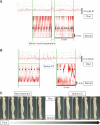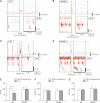Association Between the Cool Temperature-dependent Suppression of Colonic Peristalsis and Transient Receptor Potential Melastatin 8 Activation in Both a Randomized Clinical Trial and an Animal Model
- PMID: 36250375
- PMCID: PMC9577569
- DOI: 10.5056/jnm21198
Association Between the Cool Temperature-dependent Suppression of Colonic Peristalsis and Transient Receptor Potential Melastatin 8 Activation in Both a Randomized Clinical Trial and an Animal Model
Abstract
Background/aims: Several studies have assessed the effect of cool temperature on colonic peristalsis. Transient receptor potential melastatin 8 (TRPM8) is a temperature-sensitive ion channel activated by mild cooling expressed in the colon. We examined the antispasmodic effect of cool temperature on colonic peristalsis in a prospective, randomized, single-blind trial and based on the video imaging and intraluminal pressure of the proximal colon in rats and TRPM8-deficient mice.
Methods: In the clinical trial, we randomly assigned a total of 94 patients scheduled to undergo colonoscopy to 2 groups: the mildly cool water (n = 47) and control (n = 47) groups. We used 20 mL of 15°C water for the mildly cool water. The primary outcome was the proportion of subjects with improved peristalsis after treatment. In the rodent proximal colon, we evaluated the intraluminal pressure and performed video imaging of the rodent proximal colon with cool water administration into the colonic lumen. Clinical trial registry website (Trial No. UMIN-CTR; UMIN000030725).
Results: In the randomized controlled trial, after treatment, the proportion of subjects with no peristalsis with cool water was significantly higher than that in the placebo group (44.7% vs 23.4%; P < 0.05). In the rodent colon model, cool temperature water was associated with a significant decrease in colonic peristalsis through its suppression of the ratio of peak frequency (P < 0.05). Cool temperature-treated TRPM8-deficient mice did not show a reduction in colonic peristalsis compared with wild-type mice.
Conclusion: For the first time, this study demonstrates that cool temperature-dependent suppression of colonic peristalsis may be associated with TRPM8 activation.
Keywords: Animals; Colon; Peristalsis; Single-blind method; Temperature.
Conflict of interest statement
Figures







Similar articles
-
L-menthol improves adenoma detection rate during colonoscopy: a randomized trial.Endoscopy. 2014 Mar;46(3):196-202. doi: 10.1055/s-0034-1365035. Epub 2014 Feb 26. Endoscopy. 2014. PMID: 24573731 Clinical Trial.
-
Efficacy of Glycicumarin and Isoliquiritigenin in Suppressing Colonic Peristalsis in Both an Animal Model and a Clinical Trial.Biol Pharm Bull. 2024;47(2):373-382. doi: 10.1248/bpb.b23-00680. Biol Pharm Bull. 2024. PMID: 38325854
-
Antiperistaltic effect and safety of L-menthol sprayed on the gastric mucosa for upper GI endoscopy: a phase III, multicenter, randomized, double-blind, placebo-controlled study.Gastrointest Endosc. 2011 May;73(5):932-41. doi: 10.1016/j.gie.2010.12.013. Epub 2011 Feb 26. Gastrointest Endosc. 2011. PMID: 21353674 Clinical Trial.
-
TRPM8 and dyspnea: from the frigid and fascinating past to the cool future?Curr Opin Pharmacol. 2011 Jun;11(3):218-23. doi: 10.1016/j.coph.2011.06.004. Epub 2011 Jun 30. Curr Opin Pharmacol. 2011. PMID: 21723782 Review.
-
The cool things to know about TRPM8!Channels (Austin). 2020 Dec;14(1):413-420. doi: 10.1080/19336950.2020.1841419. Channels (Austin). 2020. PMID: 33147416 Free PMC article. Review.
Cited by
-
TRP (transient receptor potential) ion channel family: structures, biological functions and therapeutic interventions for diseases.Signal Transduct Target Ther. 2023 Jul 5;8(1):261. doi: 10.1038/s41392-023-01464-x. Signal Transduct Target Ther. 2023. PMID: 37402746 Free PMC article. Review.
-
The Role and Function of TRPM8 in the Digestive System.Biomolecules. 2024 Jul 21;14(7):877. doi: 10.3390/biom14070877. Biomolecules. 2024. PMID: 39062591 Free PMC article. Review.
-
A Comprehensive Review on the Regulatory Action of TRP Channels: A Potential Therapeutic Target for Nociceptive Pain.Neurosci Insights. 2023 Dec 24;18:26331055231220340. doi: 10.1177/26331055231220340. eCollection 2023. Neurosci Insights. 2023. PMID: 38146332 Free PMC article. Review.
-
MetaCGRP is a high-precision meta-model for large-scale identification of CGRP inhibitors using multi-view information.Sci Rep. 2024 Oct 21;14(1):24764. doi: 10.1038/s41598-024-75487-x. Sci Rep. 2024. PMID: 39433940 Free PMC article.
-
The Effect of Increasing Bath Temperature on the Contractile Responses of the Large Gut in Adult and Neonate Rats.Cureus. 2023 Oct 3;15(10):e46446. doi: 10.7759/cureus.46446. eCollection 2023 Oct. Cureus. 2023. PMID: 37927690 Free PMC article.
References
LinkOut - more resources
Full Text Sources

